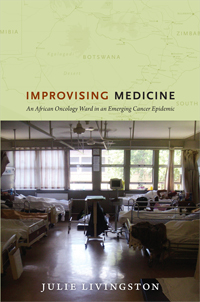
Review: Improvising Medicine – An African Oncology Ward in an Emerging Cancer Epidemic (Julie Livingston, 2012)
In contemporary medical anthropology, a growing body of ethnographies of care, increasing inquiry into public health and therapeutic practice centered in the global South emerges contributing to debates on biomedical ethics. Unlike most researchers with an interest in healthcare in southern Africa who tend to focus on HIV/AIDS, Julie Livingston (2012) looks beyond the still most challenging, albeit obscuring envelope of AIDS revealing an emerging cancer epidemic. With her study on cancer in Botswana, she is a representative of an anthropology of the body – accentuating bodily experience and suffering in a way being as close to biological and social reality as possible, thereby extending the paradigm of the ’suffering slot‘ (Robbins, 2013).
She conducted extensive fieldwork in the small cancer ward in Princess Marina Hospital (PMH) in Botswana’s capital Gaborone, which has the only dedicated oncology in Botswana. Livingston identifies Batswana cancer patients and oncology staff as part of a global therapeutic community – embedded in oncology as an international politico-cultural practice and dynamic body of knowledge –, likewise acknowledging that cancer in Botswana (and in Africa) is located at the very periphery of oncological imaginition. Locating African and transnational oncolocy in a longer time frame, she reflects on long-standing western images of African health and illness that have led to notions of infectious diseases as the prominent African health problem, and simultaneosly to the marginalization of African cancers, related to Euro-American understandings of cancer as a „disease of civilization.“ However, there is a rising tide of cancers across the golobal south and Africa in particular, and these cancers are widely invisible, the gap between African and metropolitan oncology diverging, the allocation of money, technologies, and drugs dedicated to cancer treatment centered in the global West. Beside this, it is struggling to adapt western metropolitan models to African contexts, which often leads to mismatches and imbalanced processes of knowledge and technology transfer. Ultimately, Livingston argues, the emerging cancer epidemic will shape public health in sub-Saharan Africa.
In her “hospital-based ethnography,“ she reflects on the daily routine in the PMH cancer ward, a place of serious suffering, of hope, boredom, laughter, and of death – being an utterly social space, where not only healing treatment, but also palliation of pain and profound care are demanded. Making comparative switches to oncology in North America, the author shows how the “creation“ of cancer, its consolidation as a concrete biomedical object, differs in Botswana and the global North due to specific conditions, conversations and imaginations, whereas cancer itself is a global problem, everywhere connected with universal human problems of pain, illness, disfigurement, and death.
Among insufficient technological equipment, limited stock of drugs, notorious time pressure, a lack of professional counseling and hospice care, an instability of knowledge, the additional pressures of the AIDS epidemic, and many further challenges, bed-space scarcity is one of the most acute problems the PMH cancer ward faces. Within this field of troubling conditions, Livingston investigates the interactions of patients, their relatives, and the ward staff consisting of black nurses, black clinical assistents and the white German oncologist – taking into account the several imbalances of the hierarchical constellations herein. Furthermore, she observates how cancer experience, hope, and notions of futility are built up through practices in the ward’s social nexus.
One of the foremost characteristics of the practice in PMH cancer ward Julie Livingston makes out is the imperative of clinical improvisation due to the manyfold contingencies. That clinical knowledge itself is in many respects ill-suited to African clinical contexts, furthers the application of clinical improvisation as a defining feature of biomedicine in Botswana and in Africa, bringing about contingent tailoring of biomedical practice and knowledge. It renders the treatment paths pre-eminently based on evidence and experience, and it may lead to innovation and ethical dilemmas alike. Also the nature of decision making in the given clinical conditions is one of Livingston’s focuses: She reveals a basic pragmatism that underlies clinical communication and practice often causing ethical dilemmas, especially when “surrendered“ patients are sent back home with their deadly cancer wounds because of the need of their bed. Emphasizing the structural inequality between caregivers and care-receivers, Livingston describes the ways of disciplining patients as biomedical subjects, the cultivation of trust, the problem of translation, and most notably the tensions turning out between patient self-determination and a highlightened medical paternalism.
Most striking in Julie Livingston‘ elaborated account is, clearly, her commitment to the meanings, practices and politics of care, and thereby her stress on the interrelated complex of care, ethics and bodily experience. Care-giving is central to the daily practice in the PMH oncology, and a morally pressing endeavor. It lies at the very heart of the cancer ward, which, as a whole, Livingston depicts as a powerfully embodied social, moral, and existential space. The author affirms this image by identifying the in the ward omnipresent experiences of pain, illness, disfigurement, and death as deeply social ones. The cancer patient with his suffering and his disgust evoking, stinking cancer wounds threatens dehumanization. It is the major task of nurses to rehumanize their patients‘ bodies through profound care, the hearty cleaning of the cancer wounds, without any expression of disgust. Here, a deep and explicit understanding of care as a densely social dynamic, central to the Tswana ethics, comes into play. The nurses embody these ethics, the collective moral imagination (the Tswana humanist concept of botho) putting emphasis on empathy. Additionally, most of them are inspired by the logics of Christian healing prophesy. Intimacy and empathy make up the intersubjective phenomenology of care: Nurses often develop intimate, long-term relations to patients and/or their relatives. Relatives, on their part, usually monitor care, and influence the social dynamics in the ward in many respects. Sometimes the nurses have the obligation to substitute a patient’s relatives. Acting according to logics of “social“ healing, they mitigate the social isolation of illness, preventing the patients‘ social death.
Morally highly critical is the boundary between harming and healing in the ward: Treatments like chemotherapy and radiation therapy cause immense pain and suffering. The patient’s bodily experience effected by such unpleasant biomedical practice is amidst the considerations Livingston is concerned with in her investigation of forms of bodily consciousness. She pays attention to how patients gain bodily and cognitive knowledge about their disease, and how bodily consciousness is socialized. Important in this regard are the phenomenons of pain and laughter in the ward – clinical jokes about one’s own or other’s suffering or even jokes about dying and death. According to Livingston’s understanding, pain is not an object restricted to an individual body, but a relation not separated from the wider flow of social experience, a social fact itself. This social approach to pain emphasizing its situatedness, helps to unravel certain phenomena: Why, despite the accessible resources, are the nurses so reluctant to give their patients sufficient doses of analgesics in the face of their severe pain? Why, given the national ethos of care and empathy, remained an ethics of pain palliation until recently so indistinct in Botswana and southern Africa? Why are there habitualized performances of silencing patients (repressing pain expression) and of laughter in the face of loudly expressed pain to be observed in the cancer ward? Here, the slightly functionalist nature of Livingston’s reasoning gains prominence. She identifies African reluctance to perform pain loudly as a function of culture, envisioning forbearance as an culturally expected form of autopalliation missunderstood by early British and American observers. These stated an image of pain-resistant, callous Africans, and cultivated notions of racialized differences of pain experience. A subtle performance of racializing pain Livingston even met during her fieldwork in the PMH cancer ward. Concerning the laughter when cultural norms demanding silent bearing of pain fail to be enacted, Livinstone underscores the social effects of this laughter: It reestablishes embodied sociality providing intimacy and social connectivity.
Livinstone’s social analysis of cancer brings together the many experiential and emotional spheres surrounding the illness, habitualized cultural attitudes, and links to the wider political and economic context of healthcare in southern Africa, revealing the fragility of the local institutions. In her monograph, I especially appreciate the way she calls into question the preceptive, heroic master narratives of cancer in the global North, the basic assumptions about illness, death, hope, and medicine that many patients, their clinicians, and family members in this part of the world often take for granted. With her depiction of cancer and its dramatic bodily and social experience in Botswana she sets a counterpart, which yet accentuates the human universals as part of cancer. Her reference to knowledge production and to local Tswana healers, however, is lesser than I would have expected and wished. But despite this, there is not much I miss in her elaborated account that makes cancer in Botswana poignantly and devastatingly visible in a strong ethnographic writing.
References:
Livingston, Julie: Improvising Medicine – An African Oncology Ward in an Emerging Cancer Epidemic. Duke University Press, Durham & London 2012.
Robbins, Joel: Beyond the Suffering Subject: Toward an Anthropology of the Good. In: Journal of the Royal Anthropological Institute, Volume 19, September 2013, Issue 3, pp 447-462.


et reiciendis at eum quo quia odio repudiandae delectus et earum pariatur autem. qui ab velit omnis fugit ratione sit et distinctio voluptatem. eum non facilis optio quo nulla.
et facere dolores perferendis quisquam ab aperiam ex necessitatibus autem rem fugit molestiae laborum similique. atque iste pariatur repellat enim ab explicabo rerum consequatur tempore repellat. elig
similique voluptatum omnis repudiandae ipsum dolore dolore suscipit quo ut sint similique id corrupti est. dignissimos et sunt qui dolores excepturi dolores magnam sint ullam et et consequatur laborum
quis iusto nemo perspiciatis velit voluptatem non unde rerum cumque non enim labore est ut. sint ut porro voluptas at cumque et voluptatem autem ducimus ducimus modi totam doloribus nihil enim reprehe